Source:http://ftr.wot-news.com/2014/06/19/japanese-tank-destroyers-part-i/
来源↗
Author: Daigensui (US server)
原作者:Daigensui(美服)
Today, we have another guest article, this time by Daigensui, who worked previously on getting info for the Japanese branch. She named the article…
今天博客上又有一位发表文章的嘉宾了,这次是Daigensui。她以前曾经为日系坦克情报收集做出了很大贡献。她管这篇文章叫……
Daigensui’s Rescript: Late Coming Early Days Japanese TD
Daigensui的布告:姗姗来迟的早期日本TD
译注:Daigensui为罗马音,汉字为’大元帥’
This is Part 1 of the Japanese Tank Destroyer Series, dealing with the origins of tank destroyer development and the first results. Before we look into the beginnings of the pretty meager collection of Japanese tank destroyers, we need to first understand how tank destroyers came about.
这是日系TD文章的第一部分,是关于TD开发的起源,以及最初的结果的。在我们开始讨论日系那本来就不多的TD之前,我们首先需要理解TD究竟是怎么来的。
The first tank destroyers were basically stopgap solutions, mounting an anti-tank gun on a tracked vehicle and calling it a dedicated anti-tank weapon. The German Panzerjägers, anti-tank guns in an open-topped superstructure on a light tank chassis, were the major starting point for this idea. The existence of heavy French tanks like the Char B1, which were beyond the capabilities of the major anti-tank guns in service, meant that the Germans needed larger guns on mobile platforms. That is how Panzerjäger I and the Marder series came about: putting larger anti-tank guns on tank chassis to give them the mobility to keep up with the rest of the armored forces. It was only as the war went on that with more powerful tanks coming to the battlefield that we have the appearances of case mates on medium/heavy tank chassis armed with powerful guns.
第一辆TD其实是个临时解决方案,只是把一杆反坦克炮装在了一个履带车上,然后就管它叫‘反坦克专用武器’。德国的Panzerjägers(译注:英文直译”armour-hunters” or “tank-hunters”,即“装甲猎手”或“坦克猎手”,德文中简写为Pz.Jg,下同) 们,把一杆反坦克炮装在了一个轻坦底盘上,上面加装一个敞篷战斗室,是这个想法的主要起点。由于法国Char B1等等重坦的出现,现用的主要反坦克炮已经搞不定它们了,也就意味着德国人需要在移动平台上加装更大的主炮。这就是Pz.Jg I以及黄鼠狼系列的起源:把更大的反坦克炮装在坦克底盘上,以给予他们能够跟上其余的装甲部队的机动能力。但是随着战争的进行,越来越强的坦克开始出现在战场上,才有了把更加强力的主炮安装在中坦/重坦底盘上的想法。
Now, considering this background, one has to put onself into the mindset of the Imperial Japanese Army to understand why Japan was never too keen on developing tank destroyers. When your current enemy barely has any armor to speak off, and you have a non-aggression treaty with potential enemy to the north (which you fought before, and realized that your current towed anti-tank guns were adequate for the job), why would you go through the trouble of trying to stick larger guns on your already limited tank chassis? After all, your 37 mm Anti-Tank Gun Type 94 could just about deal with anything in your path, including those Western powers in Southeast Asia with their Universal Carriers, Lanchester Armoured Cars, Carden Loyd Tankette, and Stuarts. Your industrial capacity is already strained to the breaking point with a massive continental war. So, why bother with this tank destroyer nonsense?
现在要考虑时代背景了,你需要把你的思维方式调整成大日本帝国陆军(译注:简称日本陆军或IJA,下同) 那样才能够理解为什么日本从来就没有过特别热衷于开发TD。当你现在的敌人几乎没有什么装甲与你对抗,而你又与北面的潜在的敌人有着互不侵犯条约(以前你们还打过,然后发现你现在的拖行反坦克炮已经够用了),那么为什么还要自找麻烦一样的把更大的主炮装在现在已经不怎么够的坦克底盘上?别忘了,你现在的‘九四式三十七粍速射砲’已经差不多可以搞定你行进路径上几乎所有的东西了,包括东南亚那些还在用通用运载车,兰切斯特装甲车,卡登·洛伊德小坦克以及斯图尔特的西方世界力量。你的工业产能在大规模陆地战争的情况下已经几乎达到了临界点,那么你为什么还要去搞这个TD呢?
Obviously, when you realize that perhaps one or two of those enemies might be bringing something more protected.
那就是在你发现你的一个或者两个敌人把一些防护更好的东西带进战场上的时候。
Contrary to what many think today, Japan did learn quite a few lessons in the clashes with the Soviet Union. These were consolidated into Nomonhan Research Report, a classified candid document not meant for public consumption, but intended for the use of staff officers who would be charged with implementing the recommendations. Of course, most of the suggestions were ultimately not implemented as it should have been, due to the core lack of industrial capacity Japan was facing during its entire time as an empire. Regardlessly, the document did have great influence over Japanese armor development, and would be the background for the making of the Japanese tank destroyer force.
与我们今天所想的相反,日本在与苏联的冲突中的确好好的给自己上了几课。这些内容被整合在了诺门罕研究报告中,这是一份机密的盗摄报告,本不应该向公众发布的,仅限于那些管理各种建议的官员使用。当然了,绝大部分的建议由于日本在战时所要面对的工业能力不足的原因在最后都没有得到采纳。但是没有人发现这份文档对于日本装甲开发有着极大的影响,也会作为日本TD的背景文件。
Perhaps the silent complaint noted in the report was the lack of sufficient anti-tank weapons, be it the towed guns or tanks. In fact, one part noted that the troops would be annihilated without such weapons in case of a future attack, and endorsed research to design a more powerful anti-tank gun that would be necessary to defeat heavier armor likely to appear in the future. This lead directly to the development of the 47 mm Anti-Tank Gun Type 1 and its adaptation for use in Type 97 Chi-Ha Kai.
也许在报告中提到的无声的抱怨就是缺少有效的反坦克武器,就像现在的拖拽反坦克炮或者坦克不够用一样。事实上,报告的一部分提到说如果未来在没有这种武器的情况下进攻的话会造成部队的全灭,并且他们认为设计一种更强大的反坦克炮是必要的,以对抗未来有可能会出现的重装甲的敌人。这直接就导致了’一式機動四十七粍速射砲’的开发,对其进行调整后,把它安装在了‘九七式中戦車 チハ改’上。
The findings in the Nomonhan Research Report also endorsed the concept of making the anti-tank weapon the nucleus of the infantry formation, along with with suggestions for the need for a self-propelled gun as part of a comprehensive renovation of artillery. While ultimately the organic artillery of Japanese infantry divisions became so bewildering as to defy the notion of standardization, self-propelled guns did begin to appear in Japanese units. The first one, born from the fire of the Mongolian plain, was Type 1 Ho-Ni I.
诺门罕报告中的同时提出了要把反坦克武器作为步兵阵的核心的概念,他们还建议要制造一种自走炮以作为火炮的替代计划的一部分。鉴于日本步兵师的火炮组织过于混乱,自走炮的确开始出现在各种日本的单位中。第一门在蒙古平原上在战火中诞生的自走炮,就是这个’一式砲戦車 ホニ I’
Type 1 Ho-Ni I was developed by using the existing Chi-Ha chassis and engine, and replacing the gun turret with an open casemate with frontal and side armor only, while applying extra armor to the front hull. Basically, it followed the Panzerjäger idea, sticking a larger gun onto an existing tank chassis. In line with the need for both a good anti-tank weapon and self-propelled gun, Ho-Ni I was designed to operate as self-propelled artillery in the armored divisions while being armed with a relatively high-velocity gun for anti-tank purposes.
‘一式砲戦車 ホニ I’是使用了现有的’九七式中戦車 チハ’的底盘以及引擎进行开发的,他们把原来的炮塔用一个敞篷且只有正面和侧面装甲的炮塔换掉了,同时又给正面车身加装了额外的装甲板。它的理念和德国的Pz.Jg的概念差不多,把一杆更大的炮装在现有的底盘上。在日军对于好的反坦克武器和一个自走炮的双重需求下,‘一式砲戦車 ホニ I’被设计成了可以在装甲师中作为火炮进行操作,同时还有一杆初速很高的主炮用于反坦克用途。
One might ask why it took almost two year (development started in December 1939 and acceptance was in October 1941) for such a simple vehicle to come out. As it turns out, clashes about the purpose of this “gun-tank (housensha)” was the main reason for the delayed development. At least there was the simple lack of any suitable anti-tank gun until 47 mm Anti-Tank Gun Type 1 came along. Aside from this, there was the disagreement on whether this gun-tank should be purposed for anti-tank or artillery purposes. The anti-tank/artillery argument was only settled after the decision to make a separate self-propelled gun armed with a 10.5 cm howitzer (Ho-Ni II) for pure artillery purposes, with Ho-Ni I providing both long-range direct fire and anti-tank capabilities with a modified 75 mm Field Gun Type 90.
有人也许会问了,为什么他们用了两年(1939年12月开始研发,1941年10月验收)才研究出这么个小破车。其实是这样的,关于这辆“炮坦克(日文为:砲戦車——译注)” 的开发的冲突是导致开发延迟的主要原因。至少他们在’一式機動四十七粍速射砲’出现前都缺少可用的反坦克炮。除此以外,还有关于这辆坦克究竟是要用于反坦克用途还是用于火炮用途的不一致意见。反坦克/火炮的争论在他们决定要另搞一辆用10.5cm榴弹炮的单纯的火炮(一式砲戦車 ホニ II)之后终于尘埃落定,而‘一式砲戦車 ホニ I’在装备改装后的九〇式野砲后可以提供远距离直接射击和反坦克的能力。
Ho-Ni I served mostly with the 2nd Armored Division in the Philippines, where while it did not have a big impact on the battlefield, was still able to do its job sufficiently for such an outdated design. It was one of the few vehicles that could defeat a Sherman, with the veterans of the Japanese-Soviet conflicts carrying out camouflage and ambushes, managing to destroy M4 tanks from around 500 meters away. In the end, all Ho-Ni Is were destroyed, with only one example surviving in the United States.
大部分的‘一式砲戦車 ホニ I’都服役在菲律宾的第二装甲师中,虽说它对战场没有产生什么太大的影响,但是它在使用这样一种过时的设计下还是能做好自己的本职工作的。这是少数几辆可以搞定一辆M4坦克的车。部分在日苏冲突中剩下的老兵可以在利用迷彩和伏击战术的情况下,在500开外就能摧毁M4坦克。最后,所有的‘一式砲戦車 ホニ I’都被摧毁了,只有一辆样车还留在美国的某处。
For the Imperial Japanese Army, however, Ho-Ni I was not enough. In order to solve the issues of crew survivability, a fully enclosed and armored casemate was made for the upgrade, Ho-Ni III, in 1943. In addition to this, with the case mate having its flanks protruding beyond the hull sides, it provided more room for the crew and the possibility of upgunning, although such upgunning never happened due to lack of resources. Also, the gun was changed to 7.5 cm Tank Gun Type 3 Model II, a modified version of 7.5 cm Field Gun Type 90 for use in gun carriers. The breech was shorted by 300 mm to allow greater traverse (22° to each side) and elevation (-15°/+25°).
对于IJA来说,‘一式砲戦車 ホニ I’是远远不够的。为了解决乘员生存率的问题,在1943年他们搞出了一种全封闭且有装甲防护战斗室的版本,‘一式砲戦車 ホニ III’。除此以外,它的外壳的两翼向车身后方突出,给乘员提供了更大的空间以及未来对主炮的升级,但是鉴于资源不足,主炮一直未能得到升级。与此同时,主炮也被换成了用于武器运载车的‘九〇式野砲’的改装版,‘三式七糎半戦車砲II型’。它的后膛被削短了300mm以提供更大的射界(每侧22°)以及仰/俯角(-15°/+25°)
Unfortunately, unlike Ho-Ni I, Ho-Ni III was kept on the Home Islands for the “Decisive Battle” against the Allied invasion, thus never being used in actual combat.
不幸的是, 与‘一式砲戦車 ホニ I’不同,‘一式砲戦車 ホニ III’一直都被留在了日本本土以应对盟军入侵的“决定性战斗”,因此就从来没有进入过实战。
This was just the beginning of Japanese tank destroyer development. While the beginnings were humble, the start of the Pacific War meant that Japan needed more powerful vehicles, and thus began rapid improvements…..
这只是日本TD研发的开始阶段。尽管起步好像有点问题,但是由于太平洋战场的开拓就意味着日本需要更强大的车辆,于是他们就开始了快速的进步……

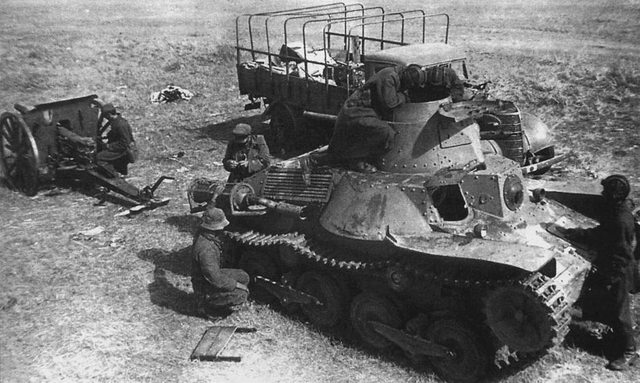
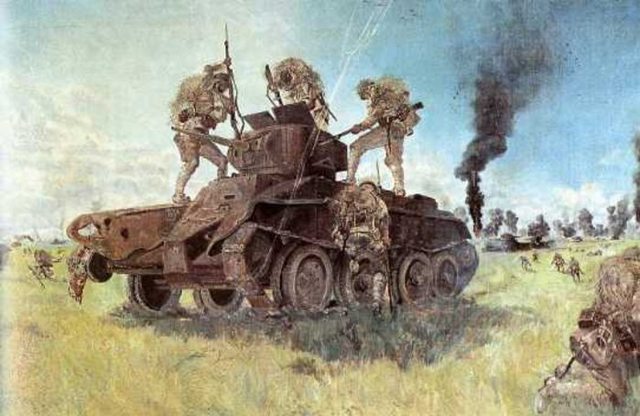
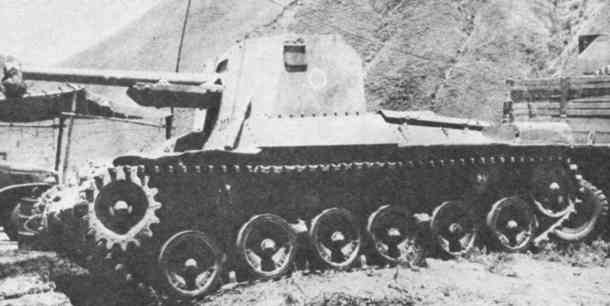
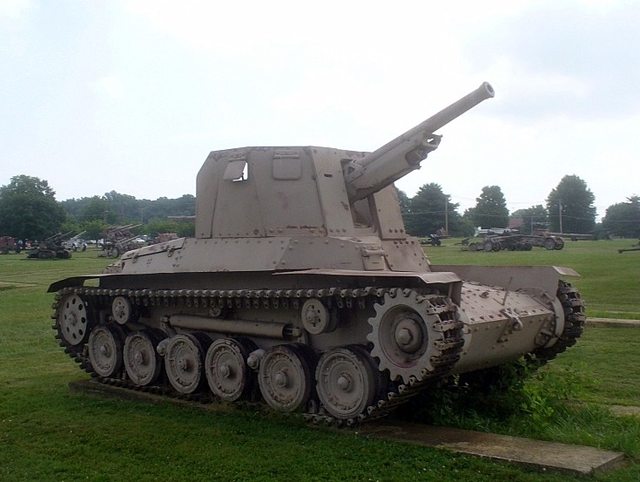
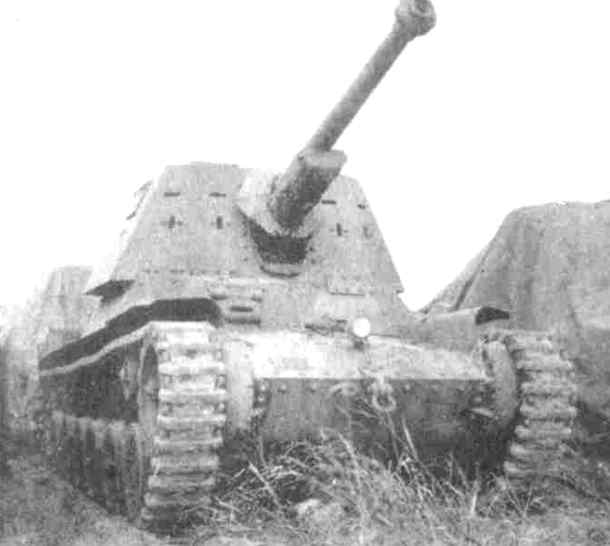
五毛们又要开始忙着tk了